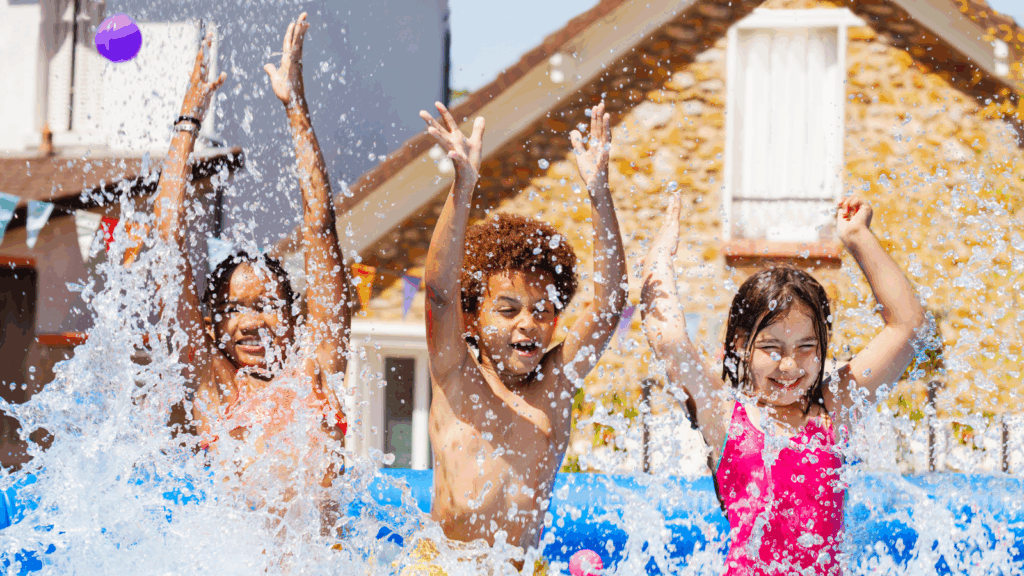
Swimming and other recreational water activities come with health and safety risks such as swimming-related illnesses and drowning. Learn what you can do to protect yourself and others from swimming-related illnesses and injuries at all types of recreational water venues, like pools, splash pads, and natural bodies of water.
WHAT YOU CAN DO TO PREVENT DROWNING:
Drowning is the leading cause of death for children aged 1–4 and the second leading cause of unintentional injury death for kids aged 5–14. Here are some tips as you dive into pool season and help protect children from drowning:
- 100% supervision — no distractions. Watch kids closely when they are in or around water. Avoid activities like being on a phone. Drowning happens quickly and quietly.
- Help prevent children from getting in your backyard pool unsupervised. Install four-sided fencing which fully encloses the pool and separates it from the house, with self-closing and self-latching gates. Drain kiddie pools and buckets after use.
- Appoint a “Water Watcher” with a visual cue like a lanyard. Know how to recognize and respond to a swimmer in distress and how to perform CPR.
- How swimmers stay visible and safe. Best swimsuit colors for visibility are neon yellow, orange, and bright pink. Use Coast Guard-approved life jackets (not floaties for kids) and wear your life jacket when on open water, even if you’re a skilled swimmer.
- Teach children basic swimming and water safety skills. Swimming lessons can reduce the risk of drowning. Children who have had swimming lessons still need close and constant supervision when in or around water.
SWIMMING RELATED ILLNESSES AND DISEASES
People can get swimming-related illnesses and diseases from germs in the water in which they swim and play. Natural bodies of water like oceans, lakes, and rivers can come with additional hazards. Knowing the safety and quality of those waters before visiting them is important. We compiled some of the CDC’s tips for healthy swimming to protect yourself and those you care about from illness at the pool and our reservoirs this summer.
POOL WATER QUALITY TIPS:
- Pee in the toilet, not the pool. When pee and chlorine mix in the pool, there is less chlorine available to kill germs.
- Do you know the truth about chlorine? It doesn’t kill germs in pools right away! While it kills most germs within minutes, some germs can live in a properly chlorinated pool for days! Protect yourself. Don’t swallow water you swim or play in.
- Shower off before you dive in. Sweat and dirt on your body can use up chlorine needed to kill germs in the pool. Showering before you get in the pool keeps chlorine levels up to help keep you and those you care about healthy!
- Take a bathroom break. Take your kids every hour to use the bathroom or check diapers. Change diapers away from the water to help keep germs from getting in.
- Swimming and diarrhea don’t mix! One person with diarrhea can contaminate the entire pool and make others sick for up to 3 weeks. Stay out of splash pads if you are sick with diarrhea. Jets can rinse germs found in poop off butts and swallowing the water with those germs can make you sick. Chlorine doesn’t kill germs instantly.
- How about pool chemicals? These chemicals protect us from germs but can cause injuries if not handled safely. Help protect kids and pets by keeping pool chemicals out of reach. Check out these pool chemical safety tips from the CDC.
WATER QUALITY TIPS FOR RESERVOIRS, LAKES, AND RIVERS:
Spending time in natural freshwater areas like lakes, rivers, and streams is a great way to enjoy the outdoors, but it’s important to be aware of potential health risks.
- Germs from human and animal waste can end up in the water—especially after heavy rain—making you sick if swallowed or if they enter through open cuts. Creeks and streams, in particular, may not be monitored for water quality and can carry a higher risk of illness.
- Before heading out, check for water quality advisories or closures. Avoid swimming if the water looks cloudy or smells bad, if you’ve recently had surgery or have an open wound, or if you’re sick with diarrhea.
- While enjoying the water, don’t swallow it, keep sand out of your mouth, and wash hands before eating. Simple precautions can go a long way in keeping your outdoor adventures safe and healthy.
- Be aware of harmful algal blooms. Known to occur in our local reservoirs, harmful algal blooms are the rapid growth of algae or cyanobacteria in water that can harm people, animals, or the environment. Going in or near water with a harmful algal bloom can make you and your animals sick. Stay out if water looks discolored, has scum, or smells bad. Follow guidance from local officials if there is a harmful algal bloom in your drinking water supply or nearby recreational body of water.
